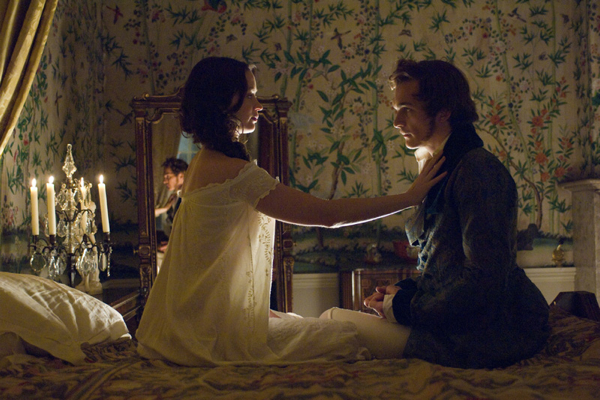Movie review by Greg Carlson
Judging from photographs as well as the popular imagination, Emily Blunt’s beautiful neck is at least twice as long as Queen Victoria’s, but historical fidelity is not the first thing on the mind of filmmaker Jean-Marc Vallee, whose “The Young Victoria” is an entertaining, sumptuous, and romantic confection. Blunt has been marvelous in several films, especially “My Summer of Love” and “The Devil Wears Prada,” and the performer capitalizes here on a title role that allows her to inject modernity into what might otherwise have been a stuffy period costume ball. Blunt’s sunny demeanor contrasts sharply with portraits of the morose majesty, and the movie is better for it.
“The Young Victoria” needs neither its obvious voiceover (it would surely be better to show, rather than tell, the audience that for Victoria, “Even a palace can be a prison”) nor its somber title cards announcing milestones in the monarch’s biography. The film could also use a great deal more of Jim Broadbent as King William IV. Broadbent relishes the puffery and pomposity of a hilarious banquet scene outburst that sends Miranda Richardson, the manipulative Duchess of Kent and Victoria’s mama, scurrying from the table. Paul Bettany is underused as Lord Melbourne and Rupert Friend is handsome as Victoria’s husband-to-be, Prince Albert of Saxe-Coburg and Gotha.
Julian Fellowes’ screenplay switches between the blossoming romance of Victoria and Albert and the political jockeying that consumes the lives of those in the young royals’ orbit. Fellowes opts to restrict the film’s point of view to the opulent quarters of the wealthy power brokers, a move that closes off any understanding of the common people who hate Victoria one day and love her the next. This lack of perspective generates even more confusion when “The Young Victoria” alludes to widespread unrest. An angry protestor chucks a brick through a window, and a slow-motion assassination attempt intrudes on Victoria’s cloistered world, but without further explanation, everyone pretty much goes about his or her business.
Despite some expository gaps, Vallee paces the 104-minute film with economy and fluidity, and as a result, “The Young Victoria” does not overstay its welcome. History nuts, certain to gripe that Albert never actually took a bullet for his wife, might leave the theater feeling a little undernourished, but the movie has more than enough climbing through the House of Hanover’s family tree to send the faithful to their encyclopedias. The depiction of the Kensington System, the elaborate set of rules forced upon Victoria by her mother, accounts for the Queen’s early unhappiness and offers the filmmakers a perfect conflict through which to dramatize Victoria’s eventual rejection of her mother’s control.
The strength of “The Young Victoria” rests with Blunt’s delightfully anachronistic performance and Vallee’s looseness with the title character’s courtship and eventual marriage to Prince Albert. Victoria’s connubial bliss, complete with an impetuous frolic in the rain and a chaste bedchamber romp, imagines a side of the ruler seldom if ever seen, and Blunt and Friend make believable the joys and the frustrations of newlyweds bound by peculiar traditions, protocols, and expectations. The script touches on gender, but never long enough to establish a substantive meditation on feminine power in interpersonal relationships.
